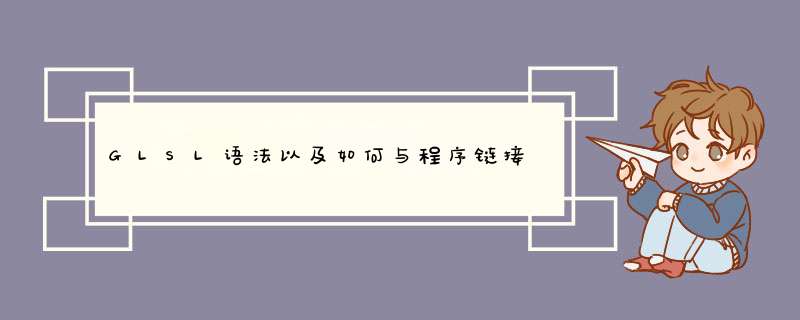
限定符
在之前的博客中也提到了,GLSL中的限定符号主要有:
attritude:一般用于各个顶点各不相同的量。如顶点颜色、坐标等。 输入
uniform:一般用于对于3D物体中所有顶点都相同的量。比如光源位置,统一变换矩阵等。
varying:表示易变量,一般用于顶点着色器传递到片元着色器的量。输出,vetexshader和fragshader数据的传递
const:常量。
privatestaticfinalStringVERTEX_SHADER="attribute vec4 position\n"+
"attribute vec4 inputTextureCoordinate\n"+
"attribute vec4 inputTextureCoordinate2\n"+
"\n"+
"varying vec2 textureCoordinate\n"+
"varying vec2 textureCoordinate2\n"+
"\n"+
"void main()\n"+
"{\n"+
" gl_Position = position\n"+
" textureCoordinate = inputTextureCoordinate.xy\n"+
" textureCoordinate2 = inputTextureCoordinate2.xy\n"+
"}"
publicstaticfinalStringALPHA_BLEND_FRAGMENT_SHADER="varying highp vec2 textureCoordinate\n"+
" varying highp vec2 textureCoordinate2\n"+
"\n"+
" uniform sampler2D inputImageTexture\n"+
" uniform sampler2D inputImageTexture2\n"+
"\n"+
" uniform lowp float mixturePercent\n"+
"\n"+
" void main()\n"+
" {\n"+
" lowp vec4 textureColor = texture2D(inputImageTexture, textureCoordinate)\n"+
" lowp vec4 textureColor2 = texture2D(inputImageTexture2, textureCoordinate2)\n"+
"\n"+
" gl_FragColor = vec4(mix(textureColor.rgb, textureColor2.rgb, textureColor2.a * mixturePercent), textureColor.a)\n"+
" }"
以上是一个典型的顶点着色器和片段着色器
inputTextureCoordinatetextureCoordinate2 顶点传入
position 绑定顶点坐标
inputImageTexture
inputImageTexture2 创建并绑定纹理
inputTextureCoordinate
inputTextureCoordinate2绑定纹理坐标
textureCoordinate2作为片段着色器的输出 最终生成gl_FragColor
对于抖音特效,其实就改变gl_Position 和 gl_FragColor
设置OpenGL ES环境创建GLSurfaceView
为了显示OpenGL的图形,你需要使用GLSurfaceView类,就像其他任何的View子类意义,你可以将它添加到你的Activity或Fragment之上,通过在布局xml文件中定义或者在代码中创建实例。
在本次的教程中,我们使用GLSurfaceView作为唯一的View在我们的Activity中,因此,为了简便,我们在代码中创建GLSurfaceView的实例并将其传入setContentView中,这样它将会填充你的整个手机屏幕。Activity中的onCreate方法如下:
<code class=“hljs” java=“”>protected void onCreate(Bundle savedInstanceState) {super.onCreate(savedInstanceState);GLSurfaceView view = new GLSurfaceView(this);setContentView(view);}</code>
因为媒体效果的框架仅仅支持OpenGL ES2.0及以上的版本,所以在setEGLContextClientVersion 方法中传入2;
<code avrasm=“” class=“hljs”>view.setEGLContextClientVersion(2);</code>
为了确保GLSurfaceView仅仅在必要的时候进行渲染,我们在setRenderMode 方法中进行设置:
<code avrasm=“” class=“hljs”>view.setRenderMode(GLSurfaceView.RENDERMODE_WHEN_DIRTY);</code>
创建Renderer
Renderer负责渲染GLSurfaceView中的内容。
创建类实现接口GLSurfaceView.Renderer,在这里我们打算将这个类命名为EffectsRenderer,添加构造函数并覆写接口中的抽象方法,如下:
<code class=“hljs” java=“”>public class EffectsRenderer implements GLSurfaceView.Renderer {public EffectsRenderer(Context context){super();}@Overridepublic void onSurfaceCreated(GL10 gl, EGLConfig config) {}@Overridepublic void onSurfaceChanged(GL10 gl, int width, int height) {}@Overridepublic void onDrawFrame(GL10 gl) {}}</code>
回到Activity中调用setRenderer方法,让GLSurfaceView使用我们创建的Renderer:
<code class=“hljs” cs=“”>view.setRenderer(new EffectsRenderer(this));</code>
编写Manifest文件
如果你想要发布你的App到谷歌商店,在AndroidManifest.xml文件中添加如下语句:
<code class=“hljs” xml=“”><uses-feature android:glesversion=“0x00020000” android:required=“true”></uses-feature></code>
这会确保你的app只能被安装在支持OpenGL ES2.0的设备之上。现在OpenGL环境准备完毕。
创建一个OpenGL平面
定义顶点
GLSurfaceView是不能直接显示一张照片的,照片首先应该被转化为纹理,应用在OpenGL square之上。在本次教程中,我将创建一个2D平面,并且具有4个顶点。为了简单,我将使用一个长方形,现在,创建一个新的类Square,用它来代表形状。
<code class=“hljs” cs=“”>public class Square {}</code>
默认的OpenGL系统的坐标系中的原点是在中心,因此4个角的坐标可以表示为:
左下角: (-1, -1) 右下角:(1, -1) 右上角:(1, 1) 左上角:(-1, 1)
我们使用OpenGL绘制的所有的物体都应该是由三角形决定的,为了画一个方形,我们需要两个具有一条公共边的三角形,那意味着这些三角形的坐标应该是:
triangle 1: (-1, -1), (1, -1), 和 (-1, 1) triangle 2: (1, -1), (-1, 1), 和 (1, 1)
创建一个float数组来代表这些顶点:
<code class=“hljs” cpp=“”>private float vertices[] = {-1f, -1f,1f, -1f,-1f, 1f,1f, 1f,}</code>
为了在square上定位纹理,需要确定纹理的顶点坐标,创建另一个数组来表示纹理顶点的坐标:
<code class=“hljs” cpp=“”>private float textureVertices[] = {0f,1f,1f,1f,0f,0f,1f,0f}</code>
创建缓冲区
这些坐标数组应该被转变为缓冲字符(byte buffer)在OpenGL可以使用之前,接下来进行定义:
<code class=“hljs” cs=“”>private FloatBuffer verticesBufferprivate FloatBuffer textureBuffer</code>
在initializeBuffers方法中去初始化这些缓冲区:使用ByteBuffer.allocateDirect来创建缓冲区,因为float是4个字节,那么我们需要的byte数组的长度应该为float的4倍。
下面使用ByteBuffer.nativeOrder方法来定义在底层的本地平台上的byte的顺序。使用asFloatBuffer方法将ByteBuffer转化为FloatBuffer,在FloatBuffer被创建后,我们调用put方法来将float数组放入缓冲区,最后,调用position方法来保证我们是由缓冲区的开头进行读取。
<code avrasm=“” class=“hljs”>private void initializeBuffers(){ByteBuffer buff = ByteBuffer.allocateDirect(vertices.length * 4);buff.order(ByteOrder.nativeOrder());verticesBuffer = buff.asFloatBuffer();verticesBuffer.put(vertices);verticesBuffer.position(0);buff = ByteBuffer.allocateDirect(textureVertices.length * 4);buff.order(ByteOrder.nativeOrder());textureBuffer = buff.asFloatBuffer();textureBuffer.put(textureVertices);textureBuffer.position(0);}</code>
创建着色器
着色器只不过是简单的运行在GPU中的每个单独的顶点的C程序,在本次教程中,我们使用两种着色器:顶点着色器和片段着色器。
顶点着色器的代码:
<code class=“hljs” glsl=“”>attribute vec4 aPositionattribute vec2 aTexPositionvarying vec2 vTexPositionvoid main() { gl_Position = aPosition vTexPosition = aTexPosition}</code>
片段着色器的代码
<code class=“hljs” glsl=“”>precision mediump floatuniform. sampler2D uTexturevarying vec2 vTexPositionvoid main() { gl_FragColor = texture2D(uTexture, vTexPosition); }</code>
如果你了解OpenGL,那么这段代码对你来说是熟悉的,如果你不能理解这段代码,你可以参考OpenGL documentation。
欢迎分享,转载请注明来源:内存溢出

 微信扫一扫
微信扫一扫
 支付宝扫一扫
支付宝扫一扫
评论列表(0条)